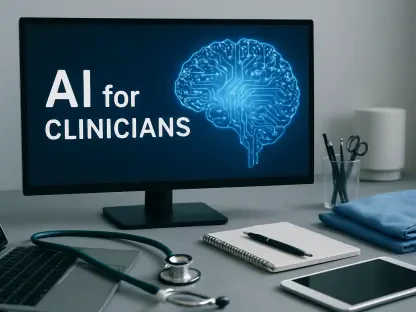Experts across technology developers, EHR vendors, and hospitals are grappling with the governance of AI as its algorithms grow increasingly pervasive in patient care operations and delivery. Concerns are rising with the growing adoption of AI and limited comprehensive supervision from the federal government. This discussion was notably highlighted at the HIMSS conference in Orlando, Florida.
AI Integration in Healthcare
The Promise and Potential
AI technology holds promise for reducing hospital costs, alleviating doctor burnout, and improving patient care. Technology giants like Google and Microsoft have made significant strides in AI tools for healthcare, collaborating with major hospital chains and EHR vendors like Epic and Meditech. This collaboration has led to an impressive range of innovative applications, from predictive analytics to generative AI, offering unprecedented opportunities for efficiency and patient outcomes.
Hospitals now have a plethora of options for AI exploration, including predictive AI and generative AI, which can generate original content. Notable instances include OpenAI’s ChatGPT, which has sparked debates about its potential to replace physician roles in certain areas. While its transformative impact on healthcare might still be far off, the current use cases for such AI tools are focused on enhancing existing processes rather than taking over human tasks entirely.
Current Applications
Current AI applications focus on low-risk, high-reward tasks such as summarizing patient records, improving shift handoffs between medical staff, and transcribing doctor-patient conversations. These applications highlight the practicality and utility of AI in handling routine, yet essential tasks that can significantly improve workflow efficiency and reduce the administrative burden on healthcare professionals. Such tools ensure more time and focus can be allocated to direct patient care.
Generative AI has been used to draft clinician replies to patient notes and operate internal chatbots for clinicians, providing valuable support in day-to-day tasks. Mayo Clinic’s proactive approach led to over 300 project proposals for generative AI, highlighting its potential in language-based and multimodal data. These initiatives reflect the global interest in leveraging AI’s potential to revolutionize healthcare communication, enhance clinical decision-making, and ensure accuracy in medical documentation.
Challenges in Oversight
Despite the advancements, responsible AI usage remains a pressing concern. Issues such as hallucination (providing incorrect or irrelevant answers), model drift (decreased performance over time), privacy, ethics, and accountability persist. In addition, bias in healthcare data continues to perpetuate existing health disparities, highlighting the necessity for vigilant oversight and proactive measures to ensure fairness.
Highmark Health and academic entities like Duke Health have established oversight processes to monitor AI governance. For instance, Duke Health evaluates model drift and bias to ensure fairness and reliability in AI projects while continuously monitoring AI system performance. These steps are essential in preventing the reinforcement of biases and guaranteeing that AI tools serve all patient demographics equitably and effectively.
Internal Controls and Standards
Ensuring Accuracy and Reliability
Hospitals and developers are taking cautious measures to ensure AI tools are accurate and unbiased through internal controls and standards groups. Meditech’s COO Helen Waters explains their extensive testing on datasets before releasing them to customers, emphasizing the importance of rigorous validation to maintain trustworthiness. Such meticulous testing processes are critical to ensuring that AI tools are both reliable and aligned with the expected clinical standards before they are integrated into patient care.
Epic, another major EHR vendor, monitors AI performance post-implementation in customer EHRs. These measures are vital for maintaining the reliability and effectiveness of AI systems in clinical settings. Continuous monitoring ensures that any deviations or unexpected behaviors in AI operations can be promptly addressed, safeguarding patient care quality and upholding the integrity of healthcare services.
Organizational Governance Structures
Health systems are actively implementing governance structures to manage AI technologies effectively. Nonprofit giant Providence, for example, has set up frameworks for testing, validating, and monitoring generative AI at all deployment phases. These structures ensure infrastructure robustness and safe AI usage, providing a well-defined pathway for the integration of AI tools from development to clinical application.
On a similar note, Sutter Health’s experience with their pneumothorax algorithm incident underscores the need for continuous monitoring and evaluation to avoid patient care impact. Such incidents accentuate the critical importance of vigilance and adaptability in overseeing AI technologies within medical environments, ensuring that patient safety remains a core priority in the deployment of innovative solutions.
Regulatory Landscape
Federal and State-Level Initiatives
The regulatory environment for AI in healthcare remains a patchwork of initiatives and rules. Various federal agencies, including CMS, ONC, and FDA, have issued targeted regulations to guide the use of AI technologies in healthcare. However, state-led initiatives also exist, adding to the complexity and variation in requirements from one state to another. A comprehensive federal strategy addressing AI governance comprehensively is still in progress.
Washington is actively working on developing a strategy for overseeing AI, with HHS initiating a new task force in January. The goal of this task force is to create robust AI quality and assurance frameworks that bridge current gaps and inconsistencies. Establishing consistent nationwide protocols is crucial for the widespread, safe implementation of AI in healthcare environments.
Role of Public-Private Partnerships
Private sector contributions are pivotal in creating a cohesive framework for AI adoption. Standards groups have emerged to develop guidelines and best practices, and public-private partnerships involve ongoing government input. Microsoft’s David Rhew emphasizes the importance of collective efforts in operationalizing standards and continuous monitoring. These partnerships are essential to deploying AI technologies ethically and effectively without stifling innovation.
Collaboration between public and private sectors ensures that AI deployment adheres to established standards while fostering an environment supportive of innovation. Such efforts enable healthcare institutions to confidently adopt new technologies without compromising safety or efficacy.
Balancing Innovation and Safety
Industry Perspectives
AI developers express openness to regulation, emphasizing the need for careful oversight to avoid hindering innovation. Meditech’s Waters advocates for a balanced approach where validating models is thorough yet not prohibitive. Developers recognize that regulations should protect patients’ safety and support technological advancements.
Hospital CEOs like Robert Garrett stress the need to align health systems with government regulations without hampering innovation. The goal is to create a collaborative environment where advancements are encouraged, and innovation continues to thrive, while patient safety remains a top priority. This balance is crucial in harnessing AI’s full potential in healthcare.
Transparency and Accountability
Experts in technology development, EHR systems, and hospitals are increasingly concerned with the governance of AI as its algorithms become more integral to patient care and treatment processes. As AI adoption spreads, the lack of stringent, comprehensive oversight from federal authorities raises significant concern. The issue of AI governance, due to its pervasive role in healthcare, has become a major discussion point. For instance, this topic was prominently featured at the HIMSS conference held in Orlando, Florida.
One primary worry among stakeholders is how to ensure that AI systems operate safely and effectively without compromising patient care. The algorithms behind AI are far-reaching, involved in various aspects from diagnostics to administrative tasks, making the need for robust governance critical. Additionally, there’s a growing awareness among hospitals and EHR vendors about the ethical implications, data privacy, and reliability of AI systems. As these technologies evolve, stakeholders are advocating for more structured oversight to prevent potential misuse and ensure these tools enhance healthcare outcomes rather than inadvertently cause harm.
The discussions at HIMSS highlight the urgency for creating policies and frameworks that allow for innovation while safeguarding patient interests. Developing a shared approach involving technology developers, healthcare systems, and regulatory bodies is essential to address these evolving challenges effectively.









